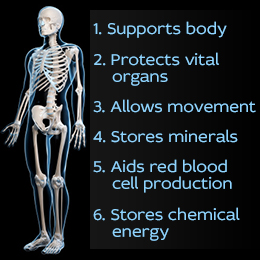There are many skeletal system functions other than providing support to the body. In this article, you will learn more on the different skeletal system facts.

The most obvious and one of the important skeletal system functions is to provide the body support and shape. Without the skeletal system, our bodies will be just mass of flesh and guts. The skeletal system helps provide a framework to your body. There are many other functions of the skeletal system that helps in many other processes in the human body system.
Functions of the Skeletal System
The skeletal system functions include:
- Support
- Protection
- Helping in movement
- Storage of minerals
- Production of red blood cells
- Chemical energy storage
The following paragraphs will discuss these functions of the skeletal system in detail.
Support
The skeletal system is made up of bones and cartilages. There are 206 bones in the body and these bones and cartilages help provide the support and points of attachment to many soft tissues, muscles and ligaments in the body. There are different types of bones like the long bones, short bones, flat bones, irregular bones and sesamoid bones. The functions also include providing rigidity and body shape. It helps supporting the weight of muscles and internal organs, without which the body would collapse.
Protection
One of the main functions of skeletal system involves protection to the soft and delicate internal organs of the body. The brain is protected by the skull, the nerves are protected by the spinal column, the rib cage provides protection to the heart and lungs. The fibrous disks between each vertebra acts as shock absorber.
Storage of Minerals
The minerals like calcium and phosphorus are stored in the bones, till they need to be distributed in various parts of the body that need minerals to carry out various functions.
Helping in Movement
The bone joint act as levers and anchors for the muscles. The point of origin of the muscle is called the anchor and the bone acts as lever. There are three types of joints, viz. fixed joint or Synarthroses like the skull bones, the slightly movable or Amphiarthroses like the symphysis pubis and the freely movable or Diarthrosis. The freely movable joints are divided into four groups. The first, ball and socket joint like the hip joint, the hinge joint in the anatomy of elbow, the pivot joint of the radius and ulna and the gliding joint are seen in the carpal joint of wrist.
Chemical Energy Storage
The yellow marrow in bones discussed above consist of adipose cells. These adipose cells are fat cells that are very important source of chemical energy.
Production of Red Blood Cells
The red blood cells as well as the white blood cells are produced in the red marrow of the bones. After birth and in early childhood, the bone marrow is red in color. Then, in adulthood, half of the bone marrow turns yellow, as it consists of fat cells. The long bones consist of yellow marrow and the red marrow is found in the flat bones of hip, skull and shoulder blades. You may also find red marrow in the vertebrae and the end of the long bone. In extreme conditions, the body can convert some of the yellow bone marrow to red bone marrow.
This is a little in brief about the skeletal system functions in the body. You are able to move because of the skeletal system and your internal organs are protected by the sturdy skeletal system. You need to eat a healthy diet and provide your bones with much-needed minerals and nutrients. It will not only help to give your stronger bones, but help in production of blood cells and energy. Thus, for your overall health and fitness, make sure your bones remain healthy. I hope this article has helped you know more on your skeletal system function, which is usually the under player.


 The most obvious and one of the important skeletal system functions is to provide the body support and shape. Without the skeletal system, our bodies will be just mass of flesh and guts. The skeletal system helps provide a framework to your body. There are many other functions of the skeletal system that helps in many other processes in the human body system.
The most obvious and one of the important skeletal system functions is to provide the body support and shape. Without the skeletal system, our bodies will be just mass of flesh and guts. The skeletal system helps provide a framework to your body. There are many other functions of the skeletal system that helps in many other processes in the human body system.